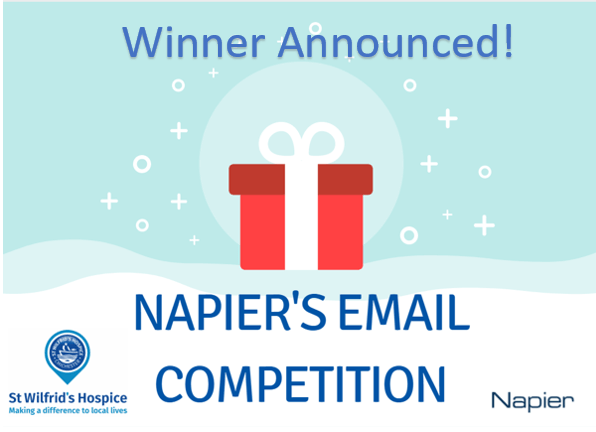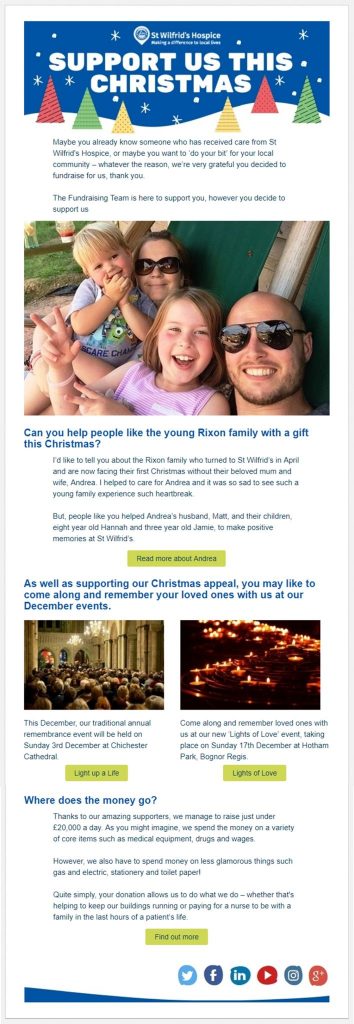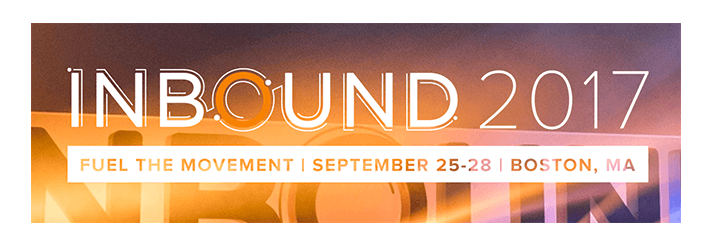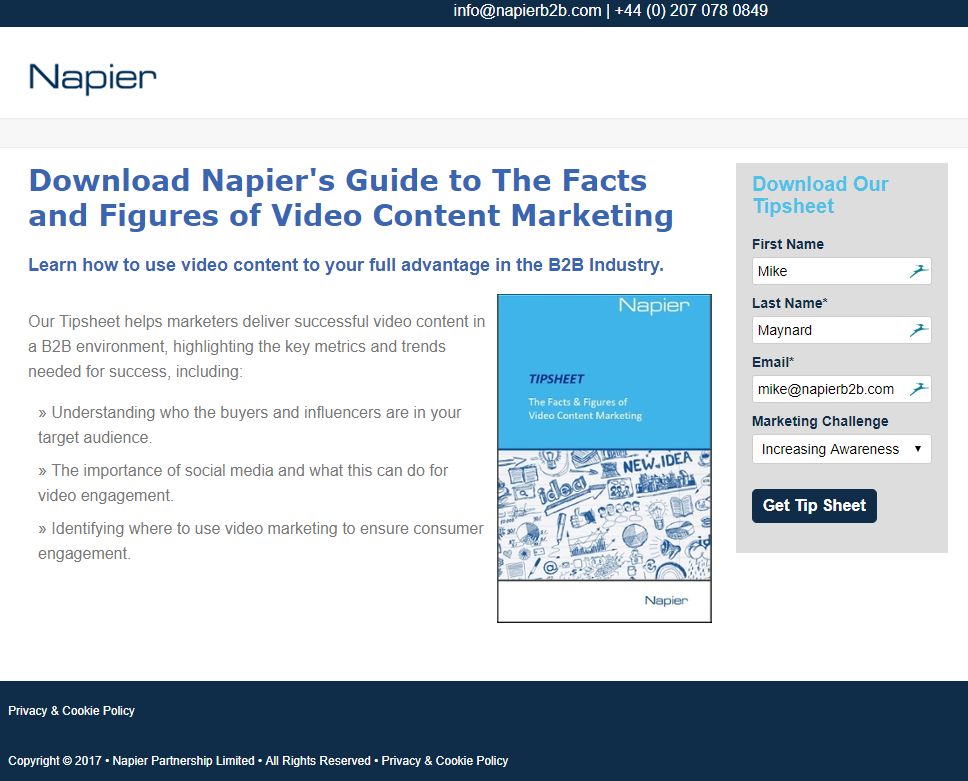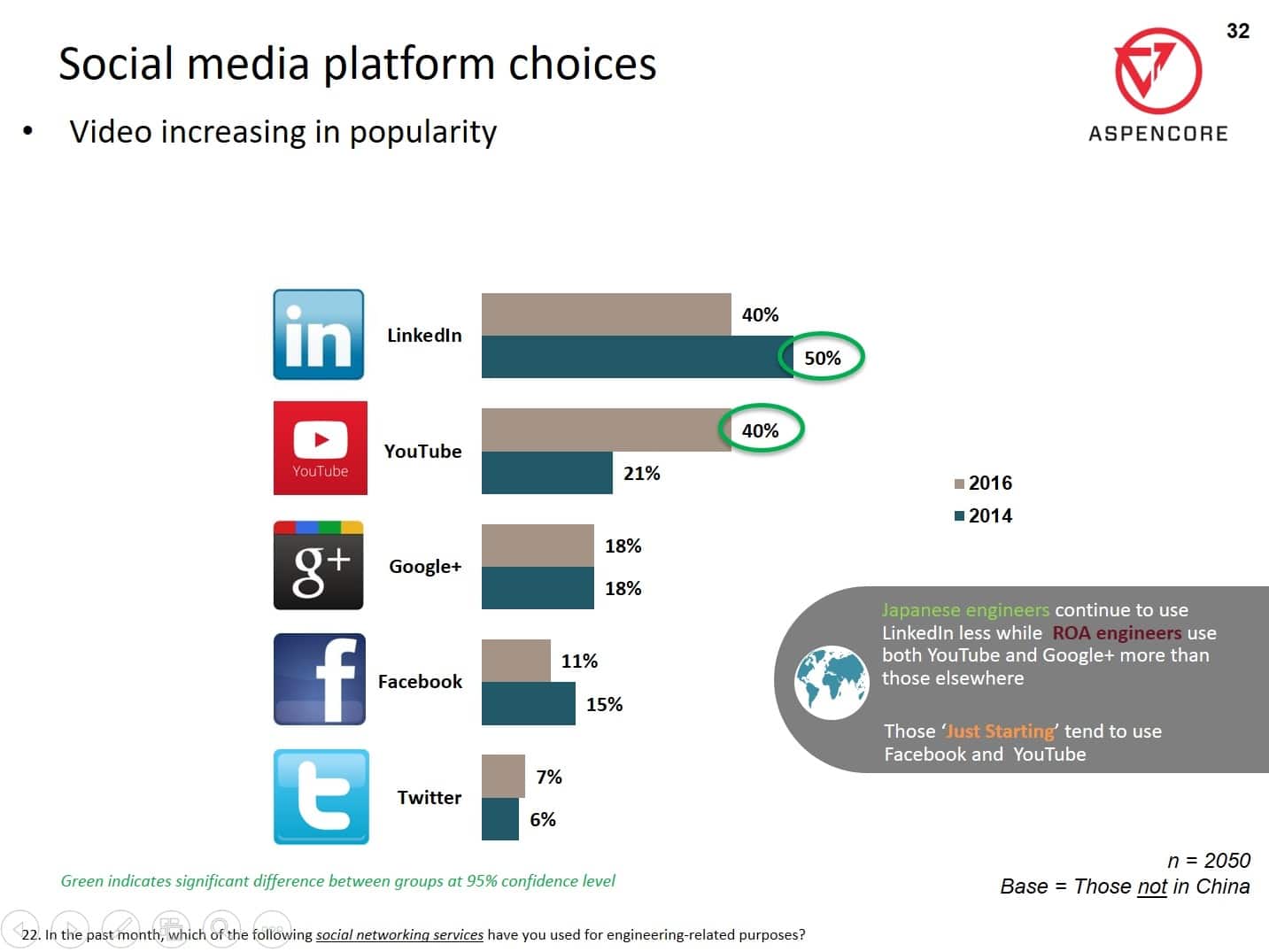Napier's Email Competition - Winner Announced!
Recently, Napier's very own Fiona Challen, Emily Serna and Hannah Kelly took part in an email design competition for St Wilfred's Hospice.
And after a close vote we are pleased to announce the winner is... Emily Serna!
See Emily's winning email design below:
Why I took a cheesy American sales course
I’ve just finished a sales course run by HubSpot. Sales? I’ve done this before in my career, so why should I spend time on another course? And anyway, wasn’t the American exuberance of previous courses enough to last me a lifetime?
Apparently not! And it’s for a good reason: marketing and sales are changing fast, and if I want to ensure that Napier continues to grow then I must keep learning. So, I decided to take the HubSpot “Sales Lion” course.
You’ll have guessed from the title that the course didn’t lack exuberance. HubSpot has all the enthusiasm and energy of a young start-up (despite being a major global corporation) and there was certainly no lack of this energy from our trainer Dan. Yes, it was sometimes hard to deal with all the super-mega-awesomeness, but the truth is that the course was good. Very good.
The premise of the course is that you should sell by helping. You don’t sell by selling, you sell by helping someone. It’s very much like the consultative sales courses that were all the rage in the last 1980s and 1990s, but the approach has been updated to reflect the change in the environment. Today marketing is responsible for much more of the customer journey than it was 20 years ago, with the internet enabling customers, particularly B2B customers, to manage much of their journey without having to talk to a sales person.
The course wasn’t always about fluffy things like “helping”. There was also a strong focus on metrics: something that we’re great at encouraging with clients, but like most agencies we can be less thorough when it comes to our sales and marketing.
The course was useful, and shows the importance of continuing to learn. I find it interesting that marketing moved from pushing products to helping with the introduction of content marketing, and now there is a similar focus for sales. I still haven’t worked out quite how HubSpot seems to help so many people: it could be because I’m just super-mega-stoked by the course, or it could be that the product is outstanding. I suspect it’s a combination of the two.
I’m going to be putting the training into practice. If you’re reading the blog and are not a customer, then maybe we’ll be talking soon. If you do get a call from me, please do let me know how well I’m doing. Hopefully you’ll find the conversation useful and will want to work with us. We’d love to work with you!
We are developing chatbots. Have we gone mad?
At Napier we have a project to evaluate and develop chatbots. Yes chatbots for B2B! I have to admit that initially I was really skeptical, but now I'm involved in the development work. So bear with me on this.
Firstly here are the basics on chatbots, a short overview written by our talented intern, Amie:
What are chatbots?
A platform used as a way of communicating using a messaging service such as Facebook, the program mimics a conversation using artificial intelligence and the new way of interaction and reaching out to clients. The program responds to questions asked by a user and responds in the most conversational way possible. It’s another way of offering online assistance without the interruption of a phone call. An example is a weather bot, you would rec the weather whenever you ask, instead of having to search for it yourself.
Why use chatbots?
It’s the first time messenger apps such as Facebook are being used for more than just social networking, these apps are now being used MORE than social networks. This is a big turning point, the advice is if you want to build a successful business you want to build one where people are! Which is where chatbots come in.
How do chatbots work?
There are currently two kinds of chatbots, one that is based on rules – this type of bot can only answer very specific questions and can’t answer if the command isn’t written in a certain way. Chatbots that use machine learning are more flexible this bot has an artificial brain/intelligence. The questions don’t have to be so specific it understands broader language and doesn’t have to be a command. This style of bot grows its intelligence the more conversations it has with people.
So why chatbots for B2B? Developing a bespoke chatbot is expensive, so we're building on the Facebook Messenger Platform. Facebook? Many clients have told us that Facebook messenger just doesn't seem the right place for a conversation with a prospect, and they also unsure that a chatbot will have sufficient intelligence. Things, however, are changing fast:
Embedding chatbots on your website
With Messenger Platform 2.2, Facebook is allowing businesses to easily embed a Facebook chatbot on their websites. Currently it's being trialed with a number of major beta customers, but we expect this feature to be available to everyone in the near future. This overcomes a significant obstacle for B2B companies by integrating chat into the website that provides the primary means of interaction with customers and prospects.
Can chatbots meet the challenge of B2B?
The final question is can a chatbot really deliver value in a B2B context? With the rapidly improving features available in tools to develop chatbots, we think they can. And we'd love to know your opinion: please try our chatbot by clicking here and let us know what you think. Email me at mike@napierb2b.com to let me know if you found it useful or just annoying.
INBOUND 2017 Taught Me: The Importance of Look-Alike Campaigns
Most marketers are familiar with look-alike campaigns: rather than simply retargeting visitors to your website, you can build campaigns to reach people who match a similar profile. This lets you reach people who fit the profile of your engaged prospects and customers, hopefully making your advertising spend much more targeted and efficient.
Although the value of look-alike campaigns is obvious, INBOUND 2017 made it clear to me that many B2B marketers have failed to pay sufficient attention to look-alike campaigns. Perhaps this is because straightforward retargeting presents a large audience for most companies. Maybe it’s because of the excitement around CRM retargeting, which is one of the technologies taking account-based marketing (ABM) to a new level. Whatever the reason, INBOUND made me commit to giving look-alike campaigns the attention they deserve.
The first announcement was the integration of support for Facebook look-alike campaigns within HubSpot. Although it grabbed attention, we’ve seen some disappointing results on Facebook. One of the themes of the conference, however, was the move from relying on third party data, such as renting email lists, to the use of first-party data. More importantly, several presenters made it really clear that we’re undervaluing our own data.
By combining our own data with the vast stores of information at Google, for example, you can start doing some very clever things. “Customer Match” lets you use Google Analytics to create an audience profile, and then target similar people with display, search, Gmail or YouTube campaigns.
The real kicker is that this ability to target look-alike audiences transforms the economics of your advertising. For example, there are probably some highly competitive keywords that you have decided simply aren’t worth the money you’d have to bid on AdWords. When you’re focussing on a look-alike group that are much more likely to convert, the economics change and the cost of the keyword suddenly looks much better value.
Look-alike campaigns are just one way that people are reversing the traditional funnel and are using their own data to segment potential customers from a broad audience. This ability to better target advertising to generate awareness offers the prospect of a step-change in the ROI of your marketing budget. We’re certainly spending more and more time on using our own data to better target our advertising, and would love to help you do the same.
Why not take a look at other posts in our INBOUND 2017 Taught me Series?
- The Top 15 Things We Learnt at INBOUND 2017
- INBOUND 2017 Taught Me: HubSpot Finally Reveals the Secrets to Achieving Explosive Success on LinkedIn
- INBOUND 2017 Taught Me: Topic Clusters
- INBOUND Taught Me: How to Win in the ever-evolving world of Social Media
Darnell Group expands social media presence on LInkedin
Darnell Group, publishers of www.PowerPulse.net and www.SmartGridElectronics.net is launching a new and improved social media presence to compliment the redesigned PowerPulse.Net website. Interestingly the focus is on LinkedIn, with the day's lead stories being posted to the company's LinkedIn page. The promise is that the page will deliver the hottest power stories before the newsletter is emailed, giving you a chance to be in the know before your colleagues.
The Napier Approach Explained
We believe that applying the right process lets our team do their best work. We often talk about our four-step approach: Determine - Focus - Deliver - Enhance. But what do we mean when we talk about these stages? Well we've created a video to explain why our approach is different from other agencies, and why it will help you achieve your marketing goals. Please enjoy viewing this new video!
Tip Sheet Explains the Facts and Figures of Video Content Marketing
Video content has been growing steadily over the last years, and has quickly become a must for B2B businesses. A massive 93% of marketers now use video in their campaigns, with 92% watching B2B videos online.
As no stranger to creating video content marketing, with our own Napier YouTube channel, we decided it was time to address the vast amount of data that explores the continual yearly increase in video marketing. Top industry sites and big players like YouTube, analyse video engagement and are more than willing to share their findings.
Our Video Content Marketing Tip Sheet highlights the key metrics and trends for video marketing, and we want to help you become inspired, to get started or freshen up your approach to video as a useful and realistic campaign medium. From video engagement to social media and video, our Tip Sheet has all it, to ensure you use video content to your advantage.
Click here to download the full version of our Tip Sheet ‘Facts and Figures of Video Content Marketing’.
Understanding the Importance of Video...
Do you know about Napier's Video Editing Capabilties? Discover what we can do:
https://napierb2b.com/2017/07/napiers-video-editing-capabilities/
PCIM Europe 2018 Call for Papers Now Open
PCIM’s European Conference 2018 has launched its Call for Papers, inviting experts from across the industry to get involved.
The conference prides itself in forming a platform for experts to exchange specialist knowledge and learn about the latest results and developments in the field of power electronics. For 2018, PCIM has taken their call for papers one step further, inviting experts from the industry and academia to apply for a lecture or poster presentation, and become a part of the conference program.
The deadline for submissions is the 16th October 2017, and the winner will receive a best paper award at the PCIM Europe Conference opening ceremony, alongside 1,000 euros and a paid trip to PCIM Asia 2019 in Shanghai.
To find out further information and how to submit your paper, please click here.
Google Updates Meaning of AdWords "Exact Match"
From the 1st April 2017, Google AdWords initiated changes to the way in which close match variants work on exact match keywords. The introduction of this change will see an expansion of close variant matching, to include the rewording and reordering of exact match keywords. In an effort to make it easier to reach consumers in different ways they search.
This change has been met with mixed reviews, with writers such as columnist Adam Levy summing up the problem in one simple sentence, that this change will affect “two major parts of what we advertisers have historically loved about exact match: preserving word order and keeping out filler, or “function,” words”. With an air of uncertainty surrounding this change, combined with the previous resistance of the introduction of close variants in 2012, it is no wonder companies are worried about the impact this change will have on their accounts.
But not to worry, for as Google’s trust in machine learning continues to grow, there is the belief that advertisers can let the algorithms take over, allowing them to focus more on other aspects of their companies. The positives continue to grow as writer Ginny Martin explained how Google pronounced that their early tests “indicate advertisers could see up 3 percent more exact match clocks on average while maintaining comparable click-through and conversion rates.”
Google is also attempting to soothe advertisers concerns, stressing that they will not change the word order or function words in exact match, if it would alter the meaning of a consumers query. With this matter resolved, it is hard to ignore the benefits this update holds for advertisers. This expansion, will grant reach for advertisers to target audience’s they never could before, as well as preventing them from having to create large lists of keywords, a vital time-saving aspect.
Although this change might take a while to adjust too, savvy companies will know how to make the most of this update, ensuring they stay in control by revisiting not only their keywords but also their negative keywords, to guarantee exact match is making as much impact for them as possible.
Results are out for the Engineer’s Social Media Report
IEEE Engineering360 Media Solutions, recently conducted its annual ‘Social Media Use in the Industrial Sector’ survey. The online survey, which results were released in the Engineering360 Research Report, looked at a broader engineering section, and asked engineers and technical professionals in the industrial sector about their frequency of social media use, which social media platforms they prefer, and what work-related activities they perform on social media.
The US based survey targeted 850 respondents who are a mixture of engineers and technical professionals, and although there were no outstanding results from the survey, there were still many interesting findings that are worth the attention.
A fascinating finding from the survey is the position social media has established in the industrial sector. As social media has evolved into a reputable media channel, more engineers and technical professionals are beginning to rely on its online services. LinkedIn is the most popular platform among the sector, with a staggering 65% of engineers and technical professionals maintaining an account on LinkedIn. Significantly, the age group 18-34 years old, maintain accounts on nearly all platforms, including Facebook, Twitter and YouTube. Delving further into the results, 54% of respondents use social media to find product reviews, whilst 43% use social media to find out expertise.
Although social media’s postion is slowly becoming more important in the industrial sector, the results reveal that it is not a leading channel or prime concern for engineers and technical professionals. 55% of respondents considered social media to have too much noise and not enough substance, whilst 64% believe social media is inefficient when compared to other methods such as search engines, supplier websites and online catalogs.
It seems the industrial sector is reluctant to accept the full benefits of social media and integrate it fully into their work activities. Yet, with the steady increase of young engineers and technical professionals joining the industry, with a massive 66% of respondents in the 18-34 group using the popular channel of YouTube for work-related purposes, it is hard to argue against social media making a bigger impact on the sector in the years to come.
Electronics Bulgaria Celebrates 5th Anniversary
Congratulations to Electronics Bulgaria who are celebrating their 5th Anniversary, having launched in 2012.
Electronics Bulgaria is the largest Bulgarian web portal for Electronics, providing specialized information on products, technologies and know-how services for the industry. It provides daily, up to date expert and valuable information for professionals working in the industrial sector in Bulgaria.
As one of the 11 specialized portals in the group IndustryInfo.bg, which holds 90,000 monthly readers and 20,000 subscribers, the Bulgarian web portal has become a popular and very useful source of information for professionals. Due to Electronics Bulgaria’s content and focus, the portal has been formed as a unique media channel connecting specialized companies with their target audiences.
We wish Electronics Bulgaria the best of luck for the future, and may their success continue.
2016 Data Protection legislation roundup
2016 was an important year for data protection. Although many marketers still find it hard to believe that legislation will determine to whom they can and cannot send emails, some found out the hard way as regulators across Europe dealt out some significant punishments.
How up to date is your data protection knowledge? Do you remember the implications of these things that happened in 2016?
- Privacy Shield (the replacement to Safe Harbor)
- The General Data Protection Regulation
- The impact of Brexit on data protection
- Digital Economy Bill
- e-Privacy Directive (which bizarrely didn't get any privacy as a draft was leaked)
Check out the review of data protection in 2016 by Osbourne Clark to find out more about what happened last year, and how it will change your marketing in 2017.
Even electronics engineers can't avoid social media!
The Mind of the Engineer survey 2016, revealed results that everyone at Napier expected: an increase in the use of social media. As the world continues to become digitalized, many no longer have a choice, and it is expected to use digital tools to help yourself learn, and expand knowledge on a new subject.
Mobile consumption of technical data has seen a huge rise in the last two years, with smartphones and tablets increasing by 15% in Europe, and a massive 32% in China. This is due to the newest generation taking hold of the world, introducing smartphones into every aspect of life. As social media becomes a must have, engineers are turning to social media sites to ensure they stay up to date.
YouTube has grown in popularity by more than 35% in the last two years, as the importance of video is becoming increasingly evident for engineers. YouTube doesn’t just provide a platform to upload blogs, tutorials or videos, it also presents the opportunity for engineers to learn new material from a variety of sources. 87% of respondents use YouTube regularly to view a video or blog post, as well as to look up and discover new or emerging technology. Although video is now crucially important to any business, due to 4 billion videos viewed daily across the world on YouTube
Surprisingly, use of LinkedIn has dropped by a massive 10% in two years. This is particularly surprising as some of our clients have found campaigns on LinkedIn to be particularly effective. Despite the fall in usage, we believe it will continue to be an important part of any business’s social media presence.
As more young engineers are being introduced into the industry, it seems inevitable that engineer’s presence on social media will continue to rise. As social media sites such as Facebook, Twitter and especially YouTube grow in popularity among young engineers, this survey has presented the engineering industry as having new opportunities and therefore having no choice but to embrace the digital age.
E&E Kompendium call for papers
E&E Kompendium 2018, the annual reference book for electronics & electronic development is looking for technical papers for its 2018 edition.
The E&E Kompendium is a crucial source of knowledge for specialists and engineers involved in the development of modern electronics products as well as executives, decision makers and technical managers in electronics & electronic development.
To share your knowledge in this unique reference book you can submit your abstract by 20th march 2017 via email f.streifinger@publish-industry.net or using the online form which can be found here: http://www.industr.com/EuE/Call-for-Papers
For more information about the E&E Kompendium see this flyer
Typical Metrics for LinkedIn Advertising Campaigns
One of the most common questions we get asked by clients is "How do we compare to other clients?" Knowing whether your campaigns perform better than similar companies running the same tactics is a really useful indication of the effectiveness of your marketing activities. Often, however, it's hard to get benchmarks against which you can compare. No one likes sharing their stats - at least not before they know they are in the top quartile of performance!
LinkedIn is one platform where we've seen significant success when both working for clients and promoting the agency. But it's hard to know whether the campaigns are doing well as there is fairly limited data available. So I was delighted to see a blog post from our LinkedIn sales consultant, Felim McMahon, that explains Benchmarking and Optimisation for LinkedIn Advertising.
In the post he gives the following very useful benchmark statistics for different "well implemented" paid campaigns on LinkedIn:
Sponsored Content
Minimum: 0.30% CTR
Range: 0.35%-0.45% CTR
Text Ads
Minimum: 0.010% CTR
Range: 0.012%-0.030% CTR
Sponsored InMail
Minimum Open Rate: 20%
Minimum CTR: 1.5%
Open Rate Range: 25-45%
CTR Range: 2-5%
The numbers give some interesting insight. Anyone who has experience of running LinkedIn advertising will know that the text ads get far fewer clicks than sponsored content (about 1/20 according to Felim's metrics). It's also interesting that you should expect around 80% of your InMails to remain unopened. The great thing about having these stats is that you can quickly compare the likely CPC for campaigns using the three different paid approaches on LinkedIn.
Obviously results will vary by industry and type of campaign (upper v. lower funnel), but Felim believes that these numbers are pretty good indications of what you should expect, and if you're not achieving these metrics then it's a sign that there is something wrong with the campaign. Our experience suggests that in B2B tech, these figures are pretty good approximations of what you should expect to achieve.
Check out our page 'LinkedIn- Everything you Need to Succeed' for further information and advice on LinkedIn.
I search engine optimised (SEO) an article, and you’ll never guess what happened next

"As a general comment, virtually all articles sent in by companies and agencies in general are not optimised sufficiently if at all. As a result they do not do well on the web."
As someone who has built two websites with very impressive traffic figures, Ian is someone I respect immensely when he talks about SEO. He pointed out that a little research around titles and keywords could enable the article to gain far more traction and return on investment, although it make take some time for the article to gain traction with Google. Unfortunately he believes that thinking about keywords and SEO simply doesn't occur to many authors.
The problem is simple: most companies are still writing articles with print publications in mind. So the titles are written to attract readers of paper publications. Ian feels that there is a tendency to focus on the company's message, rather than how the content will help the reader or the keywords that the reader might search.
This is a great point: it's far to easy to forget SEO when writing articles. It's something that the best companies and agencies understand, and those who do think of SEO will benefit substantially. Ian is keen for people to really think about how to improve the performance of the article in the SERPs: he points out that many articles don't use subheadings - an SEO tactic that is easy to implement but all too frequently forgotten.
Although there is no excuse to optimise the body copy of the article for search engines, it raises an interesting question about headlines. Titles written for Google are sometimes not the most compelling or intriguing for humans. So should we focus on SEO for headlines or take the Buzzfeed approach and try to make it impossible for readers to avoid clicking when they see the article in a list?
Ian has a simple approach to this: he believes that SEO is so important for articles hosted on publishers' websites that this should take priority. If, however, you are promoting the article on social media or a newsletter, then it is more about human interaction, and you should craft your title to drive clicks.
So although there is still room for fun, engaging headlines, article SEO is one of the things that authors could do to improve the ROI of digital PR activities. Do your keyword research and optimise the content, and you won't believe what will happen next!
Present at IDTechEx Show! 2017
The IDTechEx Show! Is the world’s largest end-user focused event on emerging technologies, bringing together material suppliers, manufacturers and end users, as it features nine co-located conferences, with one combined exhibition.
The IDTechEx Show! Is taking place in Germany, Berlin from the 10-11 May 2017. The exciting nine Co-located conferences will include fascinating subjects such as Printed Electronics, Energy Storage, 3D Printing and Wearable Technology.
Excitingly, there is a major opportunity open to experts within this event, with the chance to submit an abstract to present their own technology at the show. The selected speakers will receive a free pass giving access to 9 co-located conferences, with more than 200 exhibitors and 3000 attendees. The submitted abstracts should be between 100-400 words, and should include a presentation title, description of the technology and its applications, and what is new and innovative.
If this sounds like an opportunity, you don’t want to miss. Please send your short abstract to Cath Davies (c.davies@idtechex.com) for a chance to be part of this amazing event.
ELEKTRONIK REPORT celebrates 40 years
Congratulations to the team at ELEKTRONIK REPORT, who are celebrating 40 years of the publication with issue 6 this year (published on 14th November).
It has been a good year for the publication, with new hires in the editorial and advertising team. In a year when we've seen anniversaries for Power Pulse, Bodo's Power and Markt & Technik, it's good to see this Austrian publication also hit a major milestone.
Aktuelle Technik shakes up editorial team

Congratulations to Eugen Albisser, the new editor-in-chief at Aktuelle Technik, and Mirek Spicar as the new editor.
Eugen was previously editor- in- chief at the magazine ‘Technica’ for several years, whilst Mirek previously worked in the automaton field as an engineer, occasionally editing news and stories for Aktuelle Technik.
We wish them both the best of luck in their new roles.
eSAME confirms conference date for 2016
The organisers of eSAME (embedded Software and Micro-Electronics), the event previously known as SAME, have announced that this year’s conference will be held on 1st December 2016 at Campus SophiaTech in lovely Sophia-Antipolis, France.
The theme of this year’s conference will be “Connected objects for smarter life”. The conference has been branded a “Plateforme Conception”, and the organisers promise attendees a unique opportunity to learn more on future trends & new technical challenges within a high level technical environment.
This year, eSAME will be co-located with two other shows:
- JRE (Journée Régionale de l’Electronique): The 4th JRE show is a business oriented exhibition gathering more than 40 booths, discussion forum and live demo.
- S-Cube 2016 : The 7th EAI conference on Sensor Systems and Software: a single track forum for research on system development and software support for embedded sensing (held on 2nd December)
DATE 2017 to include focus on European projects
the organisers of DATE 2017, which will be held on 27th to 31st March 2017 in Lausanne, Switzerland, have announced that they will again have an extra section of the Proceedings dedicated to European Projects. Paper submissions of up to six pages presenting preliminary ideas, work in progress or lessons learned from the project are invited, and must be submitted before October 14th 2016 via the DATE website. Papers will be peer-reviewed and selected based on innovation and originality; in particular, the organisers will prioritise papers addressing DATE topics.
Call for papers: PCIM 2017
The organisers of PCIM 2017 have issued a call for papers. All submissions that are accepted will be published in IET Inspec-Direct, Compendex, Scopus and IEEExplore, as well as the PCIM Europe Proceedings, and there are also young engineer and best paper awards to be won at the conference.
The organisers are inviting submissions on a rand of topics, including:
- Power Semiconductors
- Thermal Management and Packaging
- Control and Drive Strategies in Power Converters
- Electronic Power Converters
- Power Electronics in Automotive, Traction and Aerospace
- Motors and Actuators
- Control Techniques in Intelligent Motion Systems
- Applications for Drives & Motion Control
- Motor Drives in Automation
- New and Renewable Energy Systems
- Energy Storage
- Smart Grid & Communication
- Power Quality Solutions
- Power Electronics in Transmission Systems
- Software Tools and Applications
- Passive Components and New Materials
- Sensors
- Metering and Diagnostics and Standards
- System Reliability
Don’t delay as abstracts are due by 18th October 2016.
New hires at Elektronik Report
A couple of new members of the team at ELEKTRONIK REPORT. Martin Schmaddebeck is a new addition to the editorial team, while Andreas Miksik has taken over advertising sales.
It's great to see this Austrian publication doing well, and recruiting new members of the team, particularly as they are celebrating the 40th anniversary of the publication later this year.
Techwatch to Organise First Dutch RF Conference
On 23 November the first Dutch RF Conference will take place at Novio Tech Campus in Nijmegen, the Netherlands. This new conference will include:
- Sessions on product-specific applications with a focus on innovative solutions in combination with advanced wireless technology
- In-depth sessions highlighting trends such as RF energy and RF power and focusing on engineers, designers and technical managers in the advanced RF field
The conference is designed to attract an audience of Belgian and Dutch high tech professionals and companies involved in high-end RF development and RF applications, and the organisers promise sessions that will interest engineers, team leaders, technical managers, product developers and innovation managers.
A call for papers is open until 1 September. Authors are encouraged to submit proposals that are "in-depth, but not academic," covering:
- Low-power RF
- RF energy
- RF power
- Innovative product applications in RF
Submissions with a close link to markets such as health/medical, automotive, telecom and communication are particularly encouraged.
Sponsorship opportunities are also available - check out the Dutch RF website for more details.
Weka mixing English and Chinese for The Elektronik
Weka Fachmedien will publish a combined English and Chinese title, The Elektronik international, as a special issue on November 2nd 2016, just in time for the industry's biggest trade show, electronica. The idea of the publication is to give a flavour of the content of Weka's German titles to other readers, with topics covered including IoT (Security, Software, Communication, Cloud, …), Industry 4.0, Wireless, Microcontrollers and Automotive.
This is the first publication in Chinese and English from a German publisher in our industry - at least as far as we are aware. We think this experimental approach is sure to be a success because of the high number of particularly American advertisers that can be reached at electronica and the other big German shows. the addition of Chinese is also interesting: although Chinese suppliers have be very active in the European market, it's only recently that they have grown their advertising spend to such an important level.
Weka plans to print 10,000 copies, focusing distribution on electronica, with some copies also available at SPS/IPC/Drives. They've planned to distribute the publication within the special ‘Chinese’ section of the fairs, targeting trade press areas and forums within these sections.

